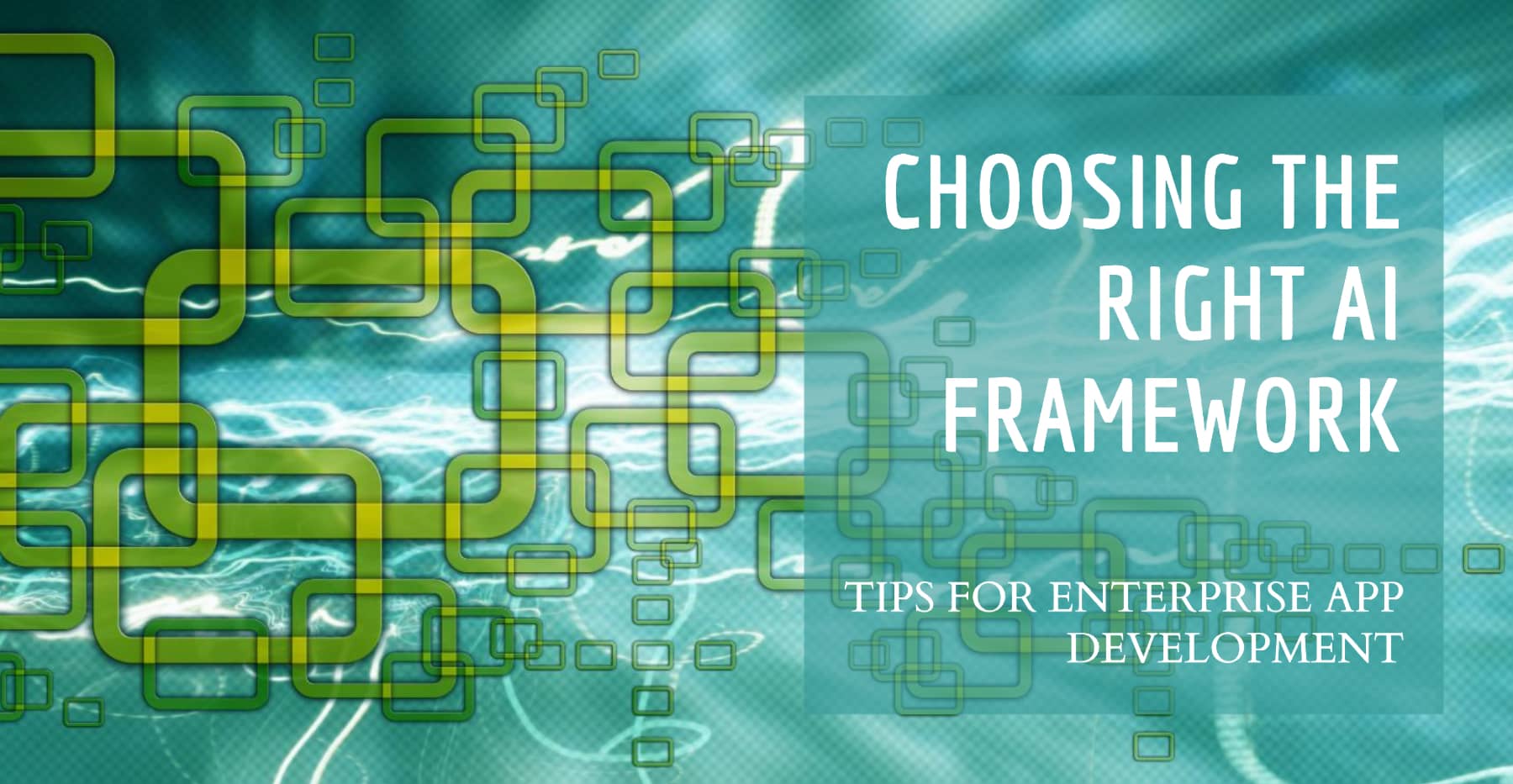In today's rapidly evolving technological landscape, artificial intelligence (AI) has become a crucial component of enterprise app development projects. Choosing the right AI framework is essential for the success of your projects, as it lays the foundation for building and deploying machine learning models efficiently. With a plethora of AI tools and frameworks available in the market, making an informed decision can be overwhelming.
In this article, we will guide you through the process of selecting the best AI model frameworks for your projects. We will explore the key considerations, compare popular frameworks, and provide actionable insights to help you make an informed decision that aligns with your project requirements and objectives.
Key Considerations When Evaluating AI Frameworks
When evaluating AI frameworks, there are several crucial factors to consider. Let's dive into each of these considerations to ensure you make the right choice for your enterprise app development projects.
Project Requirements and Specific AI Capabilities Needed
Before delving into the world of AI frameworks, it's essential to clearly define your project requirements and the specific AI applications you aim to implement. Whether you're focusing on natural language processing, computer vision, predictive analytics, or other AI domains, understanding your project's objectives will help narrow down the suitable frameworks.
Scalability, Performance, and Flexibility
Scalability and performance are critical aspects to consider when selecting an AI framework. Evaluate the framework's ability to handle large-scale data processing and accommodate the growing demands of your application. Look for frameworks that offer distributed computing capabilities, parallel execution, and optimization techniques to ensure efficient and scalable AI model training and deployment.
Ease of Use, Learning Curve, and Talent/Skills Required
Consider the ease of use and learning curve associated with the AI framework. Some frameworks may have a steeper learning curve, requiring extensive knowledge of machine learning concepts and programming languages. Assess the skills and expertise of your development team and choose a framework that aligns with their capabilities. Frameworks with comprehensive documentation, tutorials, and a supportive community can facilitate faster adoption and productivity.
Cost Considerations and Estimating Total Cost of Ownership
Evaluating the cost implications of an AI framework is crucial for budget planning and estimating the total cost of ownership (TCO). Consider factors such as licensing fees, infrastructure costs, training expenses, and ongoing maintenance. Some frameworks may offer free and open-source versions, while others require paid subscriptions or enterprise licenses. Assess the long-term costs and benefits to ensure the selected framework aligns with your budget constraints.
Community Support, Documentation, and Ecosystem
A thriving community behind an AI framework is invaluable for ongoing support, knowledge sharing, and staying up-to-date with the latest advancements. Look for frameworks with active developer communities, extensive documentation, and a rich ecosystem of libraries, tools, and extensions. Strong community support ensures access to timely assistance, troubleshooting resources, and opportunities for collaboration and learning.
Compatibility with Existing Infrastructure and Deployment Requirements
Ensure that the chosen AI framework is compatible with your existing infrastructure and deployment requirements. Consider factors such as integration with your preferred programming languages, compatibility with cloud platforms or on-premises deployments, and support for containerization technologies like Docker and Kubernetes. Seamless integration with your existing tech stack will streamline the development and deployment processes.
Security Features and Compliance Certifications
Security and compliance are paramount when dealing with sensitive data and AI applications. Evaluate the AI framework's built-in security features, such as data encryption, access controls, and authentication mechanisms. Additionally, consider compliance certifications relevant to your industry, such as HIPAA, GDPR, or SOC 2. Choosing a framework that prioritizes security and compliance will help mitigate risks and ensure the protection of sensitive information.

Choosing the Right-Sized AI Model
AI models come in different sizes, ranging from smaller specialized models to large pre-trained models. The choice of model size depends on various factors, including performance requirements, computational resources, and project complexity. Let's explore the considerations for selecting the right-sized model.
Overview of Model Sizes and Impacts on Performance and Cost
Model Size | Performance | Cost | Complexity |
Small | Moderate | Low | Low |
Medium | Good | Medium | Medium |
Large | High | High | High |
As shown in the table above, larger models generally offer higher performance but come with increased costs and complexity. Smaller models, on the other hand, may have lower performance but are more cost-effective and easier to work with.
When to Use Smaller Specialized Models vs. Large Pre-trained Models
Smaller specialized models are suitable for specific tasks and domains where high accuracy and performance are not critical. These models are faster to train and deploy, making them ideal for scenarios with limited computational resources or real-time inference requirements.
In contrast, large pre-trained models, such as large language models (LLMs), offer state-of-the-art performance across a wide range of tasks. They are trained on vast amounts of data and can be fine-tuned for specific applications. Large models are preferred when high accuracy and complex reasoning are essential, but they require more computational resources and have higher costs associated with training and deployment.
Benchmarking and Evaluating Model Performance
To select the right-sized model, it's crucial to benchmark and evaluate the performance of different models on your specific task. Consider metrics such as accuracy, precision, recall, and inference latency. Conduct experiments with various model sizes and architectures to find the optimal balance between performance and resource utilization.
Open Source vs. Proprietary Models
When choosing an AI framework, you have the option to leverage open-source models or proprietary models. Each approach has its advantages and considerations. Let's compare the key differences between open-source and proprietary models.
Factor | Open Source | Proprietary |
Cost | Free or low cost | Higher cost, often subscription-based |
Customization | Highly customizable | Limited customization options |
Support | Community-driven | Dedicated support from the provider |
Security | Depends on the community | Robust security measures |
Deployment | Flexible, self-managed | Managed services or on-premises |
Open-source models provide cost savings, extensive customization options, and flexibility in deployment. However, they may require more in-house expertise and rely on community support. Proprietary models, on the other hand, offer robust security, dedicated support, and managed services, but come with higher costs and limited customization options.
Consider your project requirements, budget, and in-house capabilities when deciding between open-source and proprietary models. If cost is a primary concern and you have the necessary expertise, open-source models may be the preferred choice. However, if security, support, and ease of deployment are top priorities, proprietary models may be more suitable.
Popular AI/ML Frameworks and Libraries
There are numerous AI/ML frameworks and libraries available, each with its unique features and strengths. Let's compare some of the popular frameworks and libraries commonly used in enterprise app development projects.
Framework/Library | Key Features | Ideal Use Cases |
TensorFlow | - Comprehensive ecosystem | - Large-scale ML projects |
| - Distributed training | - Production deployment |
| - Strong community support |
|
PyTorch | - Dynamic computational graphs | - Research and experimentation |
| - Pythonic and easy to use | - Natural language processing |
| - Extensive pre-trained models |
|
Keras | - High-level API for neural networks | - Rapid prototyping |
| - User-friendly and intuitive | - Transfer learning |
| - Runs on top of TensorFlow or Theano |
|
scikit-learn | - Wide range of ML algorithms | - Classical ML tasks |
| - Easy to use and well-documented | - Data preprocessing and analysis |
| - Integrates with other Python libraries |
|
When selecting an AI/ML framework or library, consider the following factors:
Compatibility with your preferred programming languages (e.g., Python, R, Java)
Integration with your existing infrastructure and tools
Availability of pre-trained models and transfer learning capabilities
Ease of use and learning curve for your development team
Performance and scalability requirements of your project
Community support and ecosystem for the chosen framework or library
Putting It All Together - A Framework for Evaluating AI Tools
Now that we have explored the key considerations and popular AI/ML frameworks and libraries, let's summarize the steps to evaluate and select the best AI framework for your enterprise app development projects.
Define project requirements and AI capabilities needed: Clearly outline your project objectives, specific AI applications, and desired outcomes.
Research and compare available frameworks and models: Explore the features, strengths, and limitations of different AI frameworks and models suitable for your project.
Evaluate compatibility, cost, skills, security, and performance: Assess the compatibility of the framework with your existing infrastructure, consider the cost implications, evaluate the skills and expertise required, ensure security and compliance, and benchmark the performance of different models.
Consider model size and open-source vs. proprietary tradeoffs: Determine the appropriate model size based on your project requirements and resources. Evaluate the benefits and considerations of open-source and proprietary models.
Experiment and iterate with selected tools: Conduct proof-of-concept experiments with the selected frameworks and models to validate their suitability for your project. Iterate and refine your approach based on the results.
Scale the solution, optimizing cost and performance: Once you have identified the best AI framework and model for your project, focus on scaling the solution while optimizing cost and performance. Continuously monitor and fine-tune the model to ensure optimal results.
Selecting the right AI framework for your enterprise app development projects is a critical decision that can significantly impact the success of your initiatives. By considering the key factors discussed in this article, such as project requirements, scalability, ease of use, cost, community support, compatibility, and security, you can make an informed decision that aligns with your project objectives.
Remember that the process of choosing the best AI framework is not a one-time event but rather an ongoing journey. As your projects evolve and new technologies emerge, it's essential to regularly reassess your chosen framework and adapt accordingly.
If you find the selection process overwhelming or lack the in-house expertise, don't hesitate to seek expert guidance. Collaborating with experienced AI professionals or consulting firms can accelerate your AI adoption journey and help you realize the full potential of AI in your enterprise app development projects.
By following a structured evaluation process and leveraging the insights provided in this article, you can confidently navigate the landscape of AI tools and frameworks and select the best fit for your projects. Embrace the power of AI and unlock new possibilities for innovation and growth in your enterprise.


